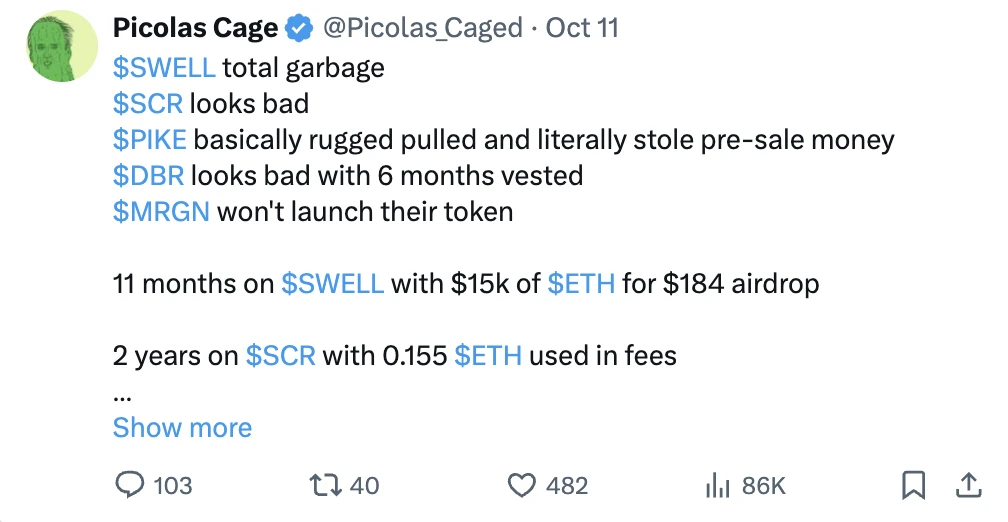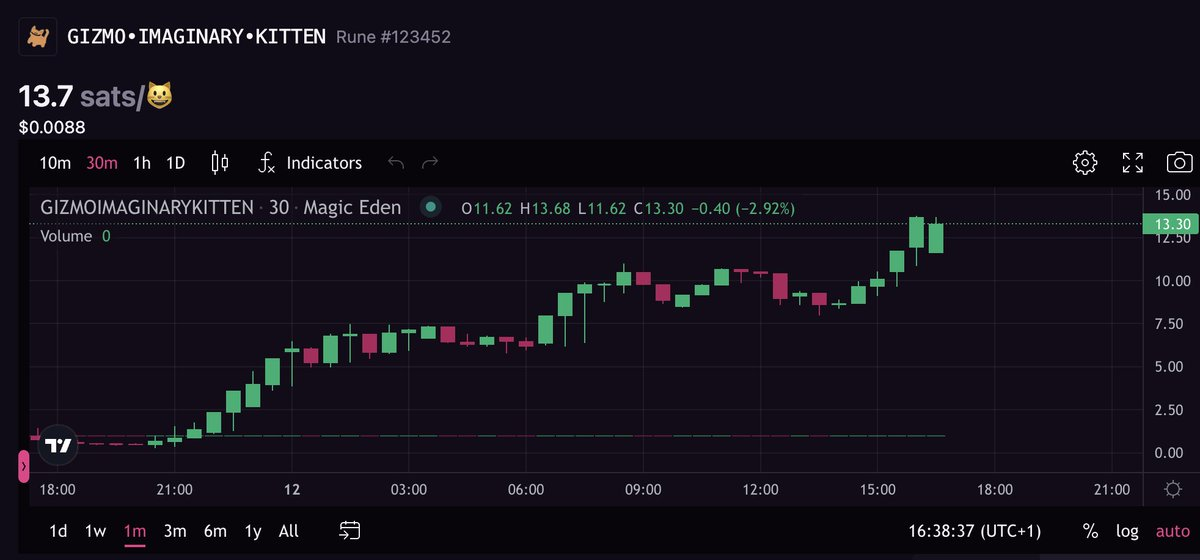Puan sistemi geriliyor, token ihracının bir sonraki merkezi neresi olacak?
Orijinal yazar: Ignas | DeFi
Orijinal çeviri: TechFlow
Every bull run brings new ways for tokens to be issued, and understanding these trends can be the most profitable strategy.
This cycle was driven by the trend of points airdrops, with projects such as Jito and Jupiter leading the way.
However, as speculators actively acquired points, the benefits they received from the airdrops were less than the cost they invested, causing the return on investment (ROI) to quickly turn negative.
(See the tweet Burada )
However, the points mechanism is just an evolution in our search for the best way to issue tokens in the market.
From the Litecoin BTC fork that required running PoW machines, to ICOs, to DeFi’s liquidity mining, the patterns are very clear: with each cycle, it becomes easier to issue tokens, and valuations continue to rise.
The launch of high FDV tokens leaves little room for new buyers, marking the decline of the points mechanism.
Now, I believe the market is correcting itself.
Valuations of low-circulation tokens have fallen due to lack of interest from new buyers, but new tokens are still launched like it’s 2023 — they raise funds for old mechanisms and design TGEs.
Locked-in terms limit their growth potential. TGEs that fail to adapt to new mechanisms will not perform well.
The slower the pace of new token issuance adapts, the longer the meme coin frenzy will last. Meme coins are the opposite of VC tokens because they have no real use, no revenue, and no future products.
In addition to Meme Coin, a notable change is that the market is returning to the state before the points mechanism emerged: protocols like Eigenlayer are turning to “programmatic incentives,” indicating the return of liquidity mining.
We’re also seeing the rise of so-called private-public sales: platforms like @echodotxyz Ve @legiondotcc where you can participate in and invest in deals where VCs are involved.
This means lower valuations and lock-up periods, just like in the ICO era, but it also requires some social connections to participate in these deals:
-
Açık @echodotxyz you need to be invited or accepted to join the exclusive group.
-
Açık @legiondotcc you can participate in deals based on social or on-chain reputation. Your speculative activity can prove that you are worthy to join the ranks of influencers and VCs.
However, these approaches cannot solve all token issuance issues due to the limited number of participants.
@CoinList “solved” this problem by randomizing access to ICO allocations. Interestingly, Coinlist launched years ago, so we’ve come full circle!
However, I believe merit-based access is superior because you are then incentivized to build your reputation on or off-chain.
So make sure you actively share your favorite projects on social media as this may bring you token allocations. Eigenlayer and Avail are just two examples of yap-to-earn model growth.
(See the tweet Burada )
Another trend that may be on the rise is “Patron Sales” launched by @infinex_app . Infinex combines a points system with a merit-based ICO where you earn points to participate in the ICO.
Notably, for the first time in recent years, it is becoming increasingly difficult to participate in token sales, marking a change from liquidity mining, fair launches, and points mechanisms.
It seems like we’ve finally realized that simply handing out free tokens doesn’t really build a community!
However, other trends are more open to everyone. Runes on Bitcoin are issued simply by paying transaction fees, keeping things transparent even with an (optional) pre-mine.
They address the lack of transparency in VC rounds, pre-sales, low-circulation tokens, and meme coin issuance.
Runes offers perhaps the fairest token issuance model. You only pay Bitcoin transaction fees, which, combined with Bitcoin’s slower speed, prevents over-issuance and wallet centralization, unlike other blockchains.
One example is the GIZMO•IMAGINARY•KITTEN token, which was minted for free and is now trading at 26 times its initial listing price.
Obviously, Runes lack the smart contract capabilities that would prevent them from being a token with real-world use, but increasingly BTC L2 could add these features.
We are also experimenting with other minting models:
-
Tap-to-earn: Popular in many developing countries, but its popularity seems to be fading.
-
Community/Social Jetons: Friend tech pioneered this model, but community monetization via tokens on Farcaster/Lens is an emerging trend (e.g. $DEGEN ).
-
Active Validation Services: AVS supported by the re-staking protocol increases the utility of tokens (e.g. rsENA x Symbiotic and re-staking MKR), although most AVS tokens are currently issued as VC tokens. Hopefully they will innovate on token issuance soon.
More models are appearing, which is a good sign!
Our goal is to identify and participate in these new token launches. Try them all and see which one makes you money relative to the effort you put in.
One of these models (perhaps one I havent mentioned here that hasnt emerged yet) will become the new hot trend, and when it does, it might be a good time to invest.
This article is sourced from the internet: The points system is declining, where will the next hotspot for token issuance be?
Related: In-depth understanding of ETH staking economics: How to design the staking yield curve?
Original article by: Ansgar Dietrich, Casparschwa, Ethereum Foundation Original translation: Bai Ding, Geek Web3 This article comes from Ansgar Dietrichs and Casparschwas discussion on the Ethereum staking mechanism and ETH issuance model on the eth research forum. Geek Web3 has sorted and edited this. These views were put forward in February 2024, and some data may be biased, but their analysis of the Ethereum staking economic model is still worth referring to, and some of the conclusions are still not outdated. Text: Currently, 30 million ETH have been staked on Ethereum, accounting for 1/4 of the total (this is the data from February this year). This proportion is quite considerable and is still rising without any signs of slowing down. The figure below shows the change of ETH stake over…











